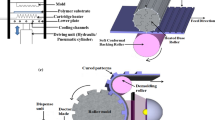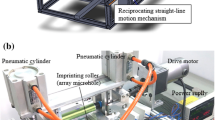Abstract
Roll-to-roll (R2R) UV embossing is a promising low cost and high throughput process that leverages on rapid photo-curing to achieve high embossing speeds for manufacturing large area functional films. There are many potential commercial applications of this process such as flexible displays and functional optical films. However, productivity improvement was hindered by the low web speed at which the system can run without losing the feature fidelity. The current work aims to study the filling-stage of the R2R UV embossing process for s via numerical simulation and experimental validation, in order to better understand the process and identify the limiting factor for productivity improvement. Coupled Eulerian–Lagrangian algorithm was employed in the simulation to consider both deformation of the solid backing film and flow of the liquid UV resin. Their interaction is deemed to influence the mold filling distance. Model predicts that for the web speed of 3 and 30 m/min, the mold filling distance increases fractionally from 2.4 to 2.8 mm, indicating that the filling stage plays a minor role in the feature fidelity control if air entrapment is not considered. Experiments with the micro feature embosser further validate the simulation in a way that to point out it is the air entrapment which causes the incomplete filling. Some basic design rules of the micro features are also provided.

















Similar content being viewed by others
References
Ahn SH, Guo LJ (2008) High-speed roll-to-roll nanoimprint lithography on flexible plastic substrates. Adv Mater 20:2044–2049
Ahn SH, Guo LJ (2009) Large-area roll-to-roll and roll-to-plate nanoimprint lithography: a step toward high- throughput application of continuous nanoimprinting. ACS Nano 3:2304–2310
Ahrens TJ (1993) Equation of state. High pressure shock compression of solids, Springer, New York
Becker H, Heim U (2000) Hot embossing as a method for the fabrication of polymer high aspect ratio structures. Sensor Actuat A-Phys 83:130–135
Guo LJ (2004) Recent progress in nanoimprint technology and its applications. J Phys D Appl Phys 37:R123–R141
He Y, Fu JZ, Chen Z (2007) Research on optimization of the hot embossing process. J Micromech Microeng 17:2420–2425
Lee HS (2007) UV nano embossing for polymer nano structures with non-transparent mold insert. Microsyst Technol 13:593–599
Li JM, Liu C, Qiao HC, Zhu LY, Chen G, Dai XD (2008) Hot embossing/bonding of a poly (ethylene terephthalate) (PET) microfluidic chip. J Micromech Microeng 18:015008
Makela T (2008) Continuous double-sided roll-to-roll imprinting of polymer film. Jpn J Appl Phys 47:5142–5144
Nezuka O, Yao D, Kim BH (2008) Replication of microstructures by roll-to-roll UV-curing embossing. Polym-Plast Technol 47:865–873
Sahli M, Khan MC, Gelin JC (2009) 3D modelling and simulation of the filling of cavities by viscoelastic polymer in roll embossing process. Int J Mater Form 2(Suppl 1):725–728
Sahli M, Gelin JC, Barrière T (2010) Numerical modelling of the polymers replicatioin in micro-cavities by the roll embossing process. Int J Mater Form 3(Suppl 1):607–610
Schift H (2008) Nanoimprint lithography: an old story in modern times? A review. J Vac Sci Technol, B 26:458–480
Shan XC, Chua KM, Soh YC, Lu CW (2009) Determining the optimal process conditions of micro roller embossing for large-area patterning of green ceramic substrates. J Micromech Microeng 19:017001
Shan XC, Lau SK, Mohahidin MB, Liu T, Lu CW (2011) Formation of large format functional films via roll-to-roll (R2R) ultraviolet (UV) embossing. In: Proceeding of IEEE 13th electronics packaging technology conference, 07–09 Dec, Singapore, E-ISBN 978-1-4577-1981-3, 521–524
Wang Q, Hiroshima H, Suzuhi K, Youn SW (2012) Real-time full-area monitoring of the filling process in molds for UV nanoimprint lithography using dark field illumination. J Vac Sci Technol B 30(6):06FB13–06FB13-6
Worgull M, Heckele M (2004) New aspects of simulation in hot embossing. Microsyst Technol 10:432–437
Worgull M, Hetu JF, Kabanemi K, Heckele M (2006) Modeling and optimization of the hot embossing process for micro- and nanocomponent fabrication. Microsyst Technol 12:947–952
Yeo LP, Joshi SC, Lam YC, Chan-Park MB, Hardt DE (2009) Numerical analyses of peel demolding for UV embossing of high aspect ratio micro-patterning. Microsyst Technol 15:581–593
Yeo LP, Ng SH, Wang ZF, Xia HM, Wang ZP, Thang VS, Zhong ZW, de Rooij N (2010) Investigation of hot roller embossing for microfluidic devices. J Micromech Microeng 20:015017
Author information
Authors and Affiliations
Corresponding author
Rights and permissions
About this article
Cite this article
Song, X., Shan, X.C., Chow, S.L. et al. Numerical and experimental study of the filling stage of roll-to-roll UV embossing process with micro features. Microsyst Technol 21, 1729–1738 (2015). https://doi.org/10.1007/s00542-014-2290-9
Received:
Accepted:
Published:
Issue Date:
DOI: https://doi.org/10.1007/s00542-014-2290-9




